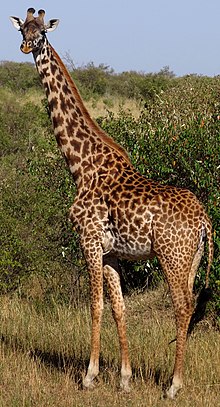Masai giraffe
This article needs additional citations for verification. (September 2014) |
| Masai giraffe | |
|---|---|

| |
| Scientific classification | |
| Kingdom: | |
| Phylum: | |
| Class: | |
| Order: | |
| Family: | |
| Genus: | |
| Species: | |
| Subspecies: | G. c. tippelskirchi
|
| Trinomial name | |
| Giraffa camelopardalis tippelskirchi Matschie, 1898
| |

| |
| Maasai Giraffe range in olive-green | |
The Masai giraffe (Giraffa camelopardalis tippelskirchi), also spelled Maasai giraffe or named Kilimanjaro giraffe, is the largest subspecies of giraffe and the tallest land mammal. It is found in Kenya and Tanzania.
Description
The Masai giraffe has jagged spots on its body. It also has a short tassel of hair on its tail. The bony outgrowths of the male's skull superficially provide the appearance of up to five ossicones. The dominant male's spots tend to be darker in colour than those of other members of its herd.
Adult males usually reach around 5.3 m in height, although they have been recorded at reaching heights of up to 5.88 m.[1][2] Females tend to be a bit shorter at around 4.3 m, with recorded height of 5.17 m (17.0 ft) tall.[1][2] Their legs and necks are both about 2–2.4 m (6.6–7.9 ft) long,[3][4][5] and their heart has a mass of roughly 12 kg (26 lb).
Behaviour
No breeding season is noted for the Masai giraffe. Females typically can breed from the age of 4. They give birth standing up. Giraffes give birth after 2–6 hours of labor. About 50–75% of the calves die in their first few months due to predation. Though many calves die, the mothers stab predators such as hyenas or lions with their sharp hooves. This can critically injure or kill a predator quickly; the Masai giraffe's kick is strong and is capable of crushing a lion's skull or shattering its spine.
Conservation
Masai giraffes at the Santa Barbara Zoo have become pregnant and successfully given birth. They are considered genetically valuable, and they are shared with other zoos.[6]
Gallery
-
Masai giraffe in Serengeti National Park, Tanzania
-
Detail of head, taken at Cincinnati Zoo and Botanical Garden
-
Two Masai giraffes in Mikumi National Park
-
Two, week-old Masai giraffes in Serengeti, Tanzania
References
- ^ a b Dagg, A.I.; Foster, J. B. (1982). The Giraffe. Its Biology, Behavior, and Ecology (with updated supplementary material). Malabar, Florida: Krieger Publishing Company.
- ^ a b Nowak, R. M. (1999). Walker's Mammals of the World. Vol. Volume 1. Baltimore, USA and London, UK: The Johns Hopkins University Press. pp. 1086–1089.
{{cite book}}:|volume=has extra text (help) - ^ Maisano, Sarah. "''Giraffa camelopardalis'' giraffe". Animaldiversity.ummz.umich.edu.
- ^ Owen-Smith R.N. (1988). Megaherbivores: the influence of very large body size on ecology. Cambridge: Cambridge University Press.
- ^ Taylor M.P. & Wedel M.J. (2013). "Why sauropods had long necks; and why giraffes have short necks". PeerJ. 1: e36. doi:10.7717/peerj.36. PMC 3628838. PMID 23638372.
{{cite journal}}: CS1 maint: unflagged free DOI (link) - ^ Gregory, Kim Lamb (May 10, 2014). "Mothers' nature in the animal world" Ventura County Star
External links
 Media related to Masai Giraffes at Wikimedia Commons
Media related to Masai Giraffes at Wikimedia Commons Data related to Giraffa camelopardalis tippelskirchi at Wikispecies
Data related to Giraffa camelopardalis tippelskirchi at Wikispecies




